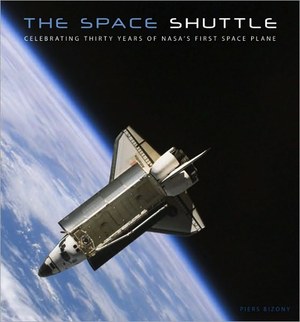Review: The Space Shuttleby Jeff Foust
|
| The bigger problem with the book is that it is, in essence, incomplete: it apparently went to print before July’s final shuttle mission, STS-135. |
As its oversized dimensions suggest, the book is principally a pictorial history of the Space Shuttle. Author Piers Bizony leads off each chapter (or “stage”, as the book calls them) with a few pages of text about various phases in the history of the shuttle program, followed by collections of images from the various shuttle missions. Each mission is mentioned in the book with its basic information (launch and landing dates, crew, etc.) and a description that can range from a few paragraphs down to a single sentence for the more obscure, classified missions. These descriptions are interspersed among the images, which themselves include some iconic photos as well as more obscure but interesting shots.
There are a few minor errors in the text, such as stating that Norm Augustine chaired the Columbia Accident Investigation Board as well as claiming, in a section on potential shuttle successors, that the DC-X “confirmed its critics’ worst fears by catching fire as soon as it reached the ground,” something that happened only after many successful test flights. The bigger problem with the book is that it is, in essence, incomplete: it apparently went to print before July’s final shuttle mission, STS-135. The brief description of the mission refers to it in the future tense, and the only included photo is from pre-launch preparations in April. In fact, the description a few pages earlier of STS-132 referred to that May 2010 mission as the last flight of Atlantis. That was true at the time, as it was only after that mission would the STS-135 mission be formally added and thus giving Atlantis one more mission, but that isn’t mentioned in the book.
It’s not clear why the publishers went to press before STS-135 flew; perhaps they wanted to be sure the book was on bookstore shelves for the holiday shopping season (the book’s official publication date was October 2.) That makes the ending of the book a bit awkward: structured chronologically throughout, the book ends not with a concluding chapter about the end of the program, its significance, and the future, but instead with a chapter about how shuttles are processed for flight, which hardly seems like an appropriate way the book.
Up until those concluding sections, though, The Space Shuttle: Celebrating Thirty Years of NASA’s First Space Plane is a good pictorial history of the shuttle. While obviously not a thorough history of the program, it does provide an overview of the program combined with often-stunning imagery from the Space Shuttle era. But as the shuttle program fades into history, there will be opportunities for more thorough, complete reviews of the shuttle era—ones that, presumably, will not leave off the final shuttle mission.
